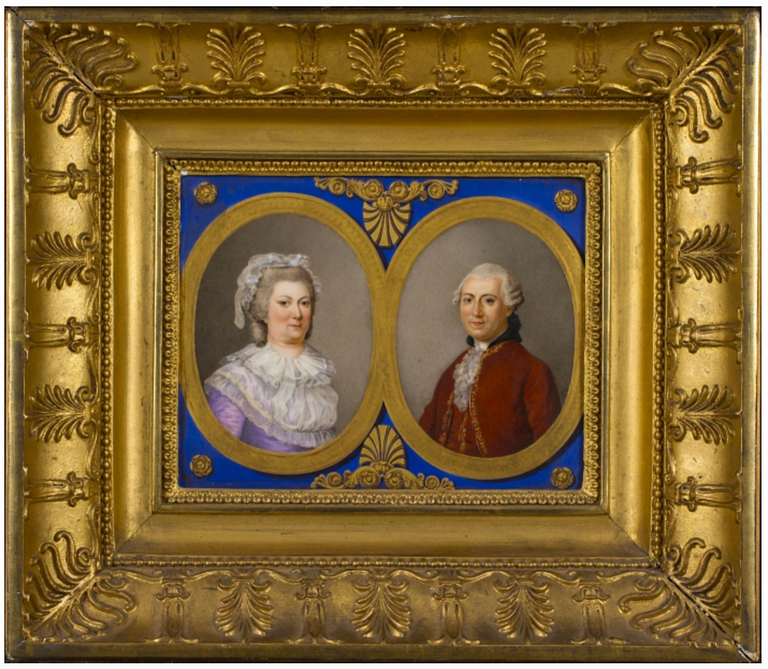Adolf Ulrik Wertmüller
Porträtt av Madame Marie-Anne-Louise Genèt (1724-1796), kallad Lise
Signerad A: Wertmüller. S [Suedois] / à Paris 1785. Duk, oval 65 x 54 cm. Samtida förgylld fransk Louis XVi ram.
Proveniens
Anne Graphie ”Sophie" Panellier d’Arsonval, née Genêt (1761-1819), married to Antoine ”Lucien” Panellier d’Arsonval;
their daughter Alexandrine Eulalie Pauline Pannelier (1787-1856), married to Francois Lambert (†1837);
their daughter Blanche Adine ”Adèle" Lambert (†1885), married to Baron Mathieu de Faviers (1817-1885);
thence by descent until 2021
Utställningar
Paris, The Salon, 1785.
Litteratur
Jfr M. Olausson, Mme Campan and her family in Miniature, in Nationalmuseum Bulletin, 13:1, 1989, p. 56 ff.
Exh. cat, Nationalmuseum, Marie-Antoinette, Porträtt av en drottning, 5 October 1989-7 January 1990
Övrig information
Madame Genèt, née Cardon, was the daughter of Pierre Francois Cardon (1695-1763 Versailles) and Henriette Cardon (1605-1780), née Quay. In 1752 she married Edme Jacques Genèt (1726-1781 Versailles), Secretary of foreign affaires, the highest-ranking clerk in the French foreign office. Genèt specialized in English politics and he published a number of important works on this subject. Two of their children held high positions at Louis XVI’s court and during the Republic, Jeanne Louise Henriette Campan (1752-1822), known as Madame Campan, was 1:st lady in waiting to Marie-Antoinette. After the revolution she was appointed headmistress of ”Maison d’education de la Légion d’honneur" by Napoleon in 1807 to promote the education of girls. She is today most famous for her memories of life at Marie-Antoinettes’s Court. Her brother, Edmond-Charles Genèt (1763-1834), was French ambassador to Russia and during the French Revolution, first minister the the USA. He is particularly known for his involvement in American affairs during Washington’s presidency, the so-called ”Genet Affair”.1
In 1785, the date of the present work, Wertmüller was preoccupied with work on his famous picture of Marie-Antoinette and her children in the park at Trianon in Versailles, commissioned by king Gustavus III on his visit to Paris during the summer 1784, but payed for by Queen Marie-Antoinette (Nationalmuseum, Stockholm) (see fig.). During the autumn 1784 and the spring 1785, Wertmüller visited Versailles on several occasions to conduct studies for the portrait. The final portrait was exhibited at the salon during the autumn 1785. Wertmüller also exhibited four other portraits at the Salon, all depicting members of the Genet family; a portrait of Madame Campan, her brother Edmond Charles Genèt, their mother Louise Cardon-Genèt, i. e. the present work, and a portrait of Madame Campan’s father-in-law. Wertmüller had been introduced to Madame and Monsieur Genèt through Gabriel Lindblom (1750-1827), a compatriot that had been employed as informator to Edmond Charles Genèt in 1774 (he returned to Sweden in 1787). Following his debut at the Salon in 1785, Wertmüller continued to paint portraits of the Genèt-Campan family. In 1787 he portrayed Madame Campan’s newborn son Henri and her sister Adelaide Auguié (Nationalmuseum NM 4881). Before Wertmüller left Paris in 1788 he portrayed Madame Campan’s mother-in-law as well as her niece and nephew Alexandrine och Lucien Pannelier.
Wertmüller recorded portraits he had been commissioned and payed for in his notebook, "Notte de tous mes ouvrages” (The Royal Library, Stockholm, extensively published by M. Benisovich, Wertmuller et son livre de raison intitulé la ”Notte”, in Extrait de la Gazette des Beaux-Arts, 1959). The present work, however, is not listed in the notebook. This suggests that it was intended as a gift to the sitter and her husband. The portrait was used as prototype on an eighteenth century porcelain plate depicting Monsieur Genet and his wife in the Albany Institute of History & Art, USA (see fig.). The existence of this plate shows that Wertmüller also painted a portrait of Monsieur Genet. This portrait, now lost, is similarily not listed in Wertmüller’s notebook.
- The "Genèt Affair”, also known as the French Neutrality Crisis, was a diplomatic incident that occurred during George Washington’s second term as President of the United States. The debate centered around whether the United States should intervene in the French Republic’s war with Great Britain and what constituted ”neutrality” under young American laws. The American public was enthralled with the French Revolution, and many desired to come to France’s aid against the European monarchs. In order to gain American aid, Edmond-Charles Genèt arrived in Charleston, South Carolina on 8 April 1793, the first minister (ambassador) to the United States from the Republic of France. Rather than proceed immediately to Philadelphia, then the capital of the United States, and present himself tp Washington right away, Genet lingered in Charleston and encouraged Amercian citizens to outfit privateer ships that could attack British merchants in the Caribbean. Genèt believed that his actions were in accordance with the Treaty of Alliance between the United States and France in 1778. He did not, however, bother to check with President Washington before involving American citizens in a war. Washington was hesitant to support the French Republic in 1793. He wanted to pursue a policy of neutrality, at least until Congress could be convened and offer its opinion.
Konstnär
Elev till Lorens Pasch d.y. och Johan Tobias Sergel i Stockholm, varefter han begav sig till Paris där han på Gustaf III:s uppdrag utförde den kända målningen av Marie Antoinette och hennes barn. Efter mer än 20 år i Frankrike med framgångsrik verksamhet som porträttmålare bl.a. även i Lyon och Bordeaux reste han till Amerika, där han kom att vistas till sin död med undantag för en kortare resa till Sverige. Vid sidan av porträtt målade han flera mytologiska scener.
Representerad på Nationalmuseum i Stockholm.






























































